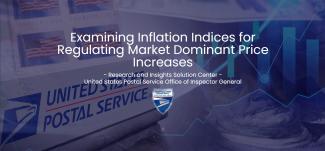Examining Alternative Inflation Indices for Regulating Market Dominant Price Increases
- The Postal Accountability and Enhancement Act capped price increases for Market Dominant products (such as First-Class Mail) at the rate of inflation as measured by the Consumer Price Index for All Urban Consumers (CPI-U). The OIG examined the potential impact on USPS’s price authority, revenue, and inflation cost coverage if, since fiscal year (FY) 2011, the price cap had been based on six alternative inflation indices instead of the CPI-U.
- These indices are: Chained CPI-U (C-CPI-U), Personal Consumption Expenditures Price Index (PCE PI), Producer Price Index-Final Demand (PPI FD), Employment Cost Index (ECI), Gross Domestic Product Price Index (GDP PI), and CPI-Delivery Services (CPI-DS).
- Impact on price authority: Between FYs 2011 and 2022, price caps based on the C-CPI-U, the PCE PI and GDP PI would have resulted in lower cumulative rate authority than the CPI-U, while price caps based on the ECI and PPI FD would have allowed slightly higher authority. The CPI-DS is a stark outlier, as it would have allowed the Postal Service to raise its rates by over twice as much as the CPI-U.
- Impact on revenue and coverage of postal cost inflation: Four of the six indices would have allowed, on average, slightly lower revenue and lower cost coverage than the authority yielded by the CPI-U. The ECI would have provided higher revenue and better cost coverage than CPI-U. In fact, the ECI would have come closest to matching postal cost inflation but would have still lagged it by an average of 0.4 percent a year. Our revenue impact figures for CPI-DS are illustrative, as we chose not to factor in price elasticities.
- Foreign postal regulators use their national CPI as a main component of the price cap, generally in combination with other authorities. In these countries, the debate is about the other authorities, rather than the merits of the CPI.
The Postal Accountability and Enhancement Act, enacted in 2006, limited price increases for Market Dominant products to the rate of inflation measured by the Consumer Price Index for All Urban Consumers (CPI-U). In 2020, the Postal Regulatory Commission (PRC), while establishing additional price authorities, confirmed the use of CPI-U in the price cap.
The USPS OIG examined the potential impact on price authority, revenue and coverage of postal cost inflation since FY 2011 if the price cap had been based on six alternative inflation indices instead of the CPI-U. We selected the Chained Consumer Price Index for All Urban Consumers (C-CPI-U), Personal Consumption Expenditures Price Index (PCE PI), Gross Domestic Product Price Index (GDP PI), Producer Price Index for Final Demand (PPI FD), Employment Cost Index (ECI), and Consumer Price Index for Delivery Services (CPI-DS). The analysis did not address the additional rate authorities such as mail density, and it did not consider mail elasticities.
Overall, the first five of these six alternative indices would have generally yielded slightly higher or slightly lower price authority, revenue, or cost coverage than the CPI-U-based price cap. Out of these five indices, ECI would have yielded the highest rate authority, revenue, and cost coverage, beating CPI-U along these three dimensions.
In theory, the sixth indicator, CPI-DS, might have generated massive financial benefits for the Postal Service. However, all findings regarding CPI-DS — which is based on private sector retail shipping prices — must be taken with extreme caution. One main reason is we did not attempt to measure what mailers’ response to higher price increases could have been.
Cumulatively, over a 12-year period from FY 2011 to the first half of FY 2023:
- Price caps based on the C-CPI-U, the PCE PI, and the GDP PI would have resulted in lower cumulative price authority than the CPI-U (28.4 percent to 31.1 percent, compared to 33.5 percent for CPI-U).
- Price caps based on the PPI FD and ECI would have allowed slightly higher price authority than the CPI-U (35.1 percent and 36.3 percent, respectively).
- The CPI-DS is a stark outlier, as it would have permitted the Postal Service to raise its rates by over twice as much as the CPI-U (86.7 percent). The CPI-DS is much more volatile than the other inflation indices, with a standard deviation two to five times as large.
Similarly, in terms of revenue generation, the C-CPI-U, PCE PI, and GDP PI — but also the PPI FD — could have generated less annual revenue (on average, between -$293 million and -$523 million). The ECI and CPI-DS could have generated more total revenue.
When assessing the overall alignment of the inflation-based price authorities with postal cost inflation (changes in labor, materials, and capital costs not attributable to changes in the quantity of resources used), the CPI-U trailed postal cost inflation by an average of 0.8 percent annually. The ECI came closest to matching postal cost inflation, but still lagged by an average of 0.4 percent a year.
|
|
C-CPI-U |
PCE PI |
PPI FD |
GDP PI |
ECI |
CPI-DS |
|---|---|---|---|---|---|---|
|
Price Authority per Rate Case Percent Difference to CPI-U Based Price Authority (Average per Rate Case FY 2011-H1 FY 2023) |
-0.3% |
-0.3% |
0.1% |
-0.2% |
0.2% |
3.3% |
|
Annual Revenue (FYs 2011-2022) Average Annual Percent Difference to Market Dominant Revenue Based on CPI-U Price Cap |
-1.2% |
-1.0% |
-0.7% |
-1.0% |
1.5% |
25.5%* |
|
Coverage of Postal Cost Inflation Average Difference to Cost Coverage based on CPI-U Price Cap (Calculated Between Each Pair of Successive Rate Increases) |
-0.2% |
-0.2% |
-0.1% |
-0.1% |
0.4% |
2.4% |
* Indicative result assuming inelastic demand.
Source: USPS OIG analysis
While using the point-to-point method to calculate price authority — instead of the PRC’s moving average technique — would have had a generally limited impact on cumulative rate authority and revenue, and on coverage of postal inflation, it would have yielded higher authority during periods of rising inflation.
Internationally, a comparison of postal price cap practices in seven European countries including France, Germany, and the United Kingdom, revealed that, like the PRC, they use their national CPI in their price cap calculation, often in conjunction with additional rate authorities addressing specific market conditions or challenges.
With a review of the Market Dominant rate-making system scheduled for 2025, the PRC faces complex decisions about how prices are set for the Postal Service’s Market Dominant products.
Jean-Philippe Ducasse, David Garcia, David Neu, and Paola Piscioneri contributed to this report.





